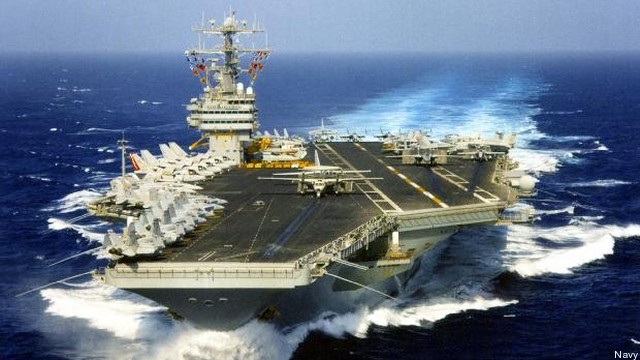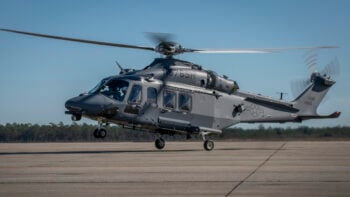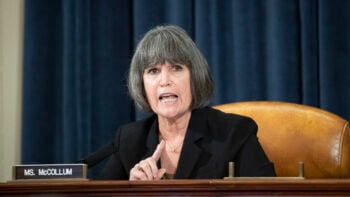 WASHINGTON: Wars have started over less. Even as the administration “rebalances” to Asia, it is scrambling to stay out of the region’s escalating territorial disputes. None is more baffling to outsiders than the three-sided conflict over the tiny, uninhabited islands known in Japanese as the Senkakus and in Chinese as the Diaoyus or the Tiaoyutai.
WASHINGTON: Wars have started over less. Even as the administration “rebalances” to Asia, it is scrambling to stay out of the region’s escalating territorial disputes. None is more baffling to outsiders than the three-sided conflict over the tiny, uninhabited islands known in Japanese as the Senkakus and in Chinese as the Diaoyus or the Tiaoyutai.
And that dispute keeps escalating. Just this morning, China’s Xinhua news service announced four warships of the rapidly growing PLA Navy had “patrolled” the waters off the Japanese-controlled isles, just the latest in a series of naval probes. On the U.S. side, the Senate passed an annual defense bill that included a (non-binding) “Sense of the Senate” amendment from Virginia’s James Webb pledging the US will stand by its treaty commitments to defend “territories under the administration of Japan,” explicitly including the Senkakus, against “armed attack.”
Those islands embroil Japan in conflict not just with mainland China but with another US ally, Taiwan. Caught in the middle between much larger neighbors and bound to the US by a de facto alliance but also to China by a deeply-felt sense of shared history, the Taiwanese give a unique and enlightening perspective on the passions driving the complex conflict that could scuttle America’s East Asian strategy.
“We have had a water-cannon war with Japan,” said former Taiwanese politician Edward I-hsin Chen, referring to a September clash in which the Japanese Coast Guard tried to drive off Taiwanese vessels with high-pressure hoses (see video). “The lesson from water-cannon warfare with Japan is we have to strengthen the power of our water cannon.”
Taiwan may be in a poor position to make good its claim to what it calls the Tiaoyutai against much larger neighbors, but it will never give up, Chen declared poetically: “We can wait another one thousand autumns.”
With two longtime allies pitted against not only each other but also against East Asia’s largest power, the US is eager to stay out. Even as the US sends aircraft carriers to reassure its allies and develops an “AirSea Battle” doctrine aimed at defeating China, senior officers have said point-blank that the US will not go to war over “rocks.”
“We don’t take sides anywhere in the world on these things,” said Pacific Command chief Adm. Samuel Locklear, repeating the administration’s mantra in a talk to the Asia Society during his visit to Washington last week. That said, he went on, “I don’t think these [conflicts] are going to go away, and we have to figure out how to get through them without miscalculation, without bringing warships and warplanes in.”
“There’s mechanisms to deal with them,” Locklear said. But he also acknowledged that, in contrast to the multiple overlapping structures created in Europe since 1945, from the European Union to the OSCE, “there is no Pacific NATO. [We] must rely on a patchwork quilt of security relationships to ensure relative peace.”
Chen, among others, wants the US to take a more active role. “The players in this region should calm down,” he said. “The United States in particular should play the role of peacekeeper [and] facilitator.”
Wait a moment, said another Taiwanese scholar, Yann-huei Song, speaking alongside Chen at a Carnegie Endowment for International Peace event. “[Regarding] the US position as an honest broker,” Song said, “I have a reservation, because of the competition between the United States and China.”
After all, the US has well-established military ties with China’s rivals, not with the PRC. And what Washington might consider “mediation,” Beijing might consider “intervention,” Song warned. He preferred a five-point plan put forward by Taiwanese President Ying-jeou Ma, with Australia or even Canada as a mediator. Indeed, Song argued, part of the reason the territorial disputes have been escalating of late — besides politicians in the region playing the nationalism card — is Beijing’s unease over the Administration’s new strategic emphasis on Asia, which has manifested largely in moving in more Navy ships and Marine Corps troops.
For all its growing power, the People’s Republic is painfully insecure. The colonial era may seem ancient history in the US, but mainland China was only reunited, bloodily, in 1949. There are Chinese elders still alive who had first-hand knowledge of how their country’s soil was occupied both by Western powers and Japan, and they see the Diaoyu/Senkaku Islands as one more stolen territory yet to be redeemed. And there are the many young Chinese who see their country as the rising power of the world, one that must be respected.
As a result, “there’s a knee-jerk reaction whenever there’s a territorial issue,” said Han-yi Shaw, the youngest of the three scholars on the panel. The Chinese public and leadership alike know their country was stripped of sovereignty when it was weak, so the obvious solution is project uncompromising strength. But that can backfire.
“I’m a little perplexed by Beijing’s approach because I thought by now they would begin to pull back from the regular incursions,” said James Schoff, one of Carnegie’s indigenous experts. “I can’t believe they actually expect they’re going to change Japan’s position [by] sending ships in and out of those waters.”
“[China] appears to be somewhat like a bully, and sometimes it pains me to see that,” Shaw agreed. “Stop saying things like ‘after all, China’s a big country and the East Asian countries are small countries.’ You don’t make any friends,” he urged Beijing. “It’s heartbreaking to me, after 100 years of our search for modernity, that we don’t understand how to articulate our case.”
Note that “we.” Even though Shaw is not only Western-educated but Taiwan-born and bred, he and many Taiwanese of his generation see mainland China as part of a greater Chinese “us,” not a menacing Communist “them.”
“I personally do believe that Taiwan/PRC has a stronger case,” Shaw said as he zipped through a slideshow citing legal documents from the Ming Dynasty, Qing Dynasty, a secret Japanese cabinet meeting of 1895, and the US-Japanese Okinawa Reversion Agreement of 1971. “The challenge is how you articulate it in the context of international law,” which Beijing tends to mistrust as a fig-leaf covering naked imperialism. Said Shaw, “what the international community can do, I think, is coach China.”
Certainly, Pacific Command is working hard to bring the People’s Liberation Army out of its historical shell. PACOM has spent years rebuilding military-to-military contacts severed in 2001 after the PRC seized a US P-3 Orion spyplane brought down on Hainan Island and detained its 24 crew.
“There’s a tendency,” said Adm. Locklear, “to use mil-to-mil relationships as a diplomatic tool if you’re unhappy with each other, and my opinion is that’s the wrong tool to be using…. You should create relationships with each other, mil-to-mil, that are strong enough to endure.”
In his Washington appearances last week, Locklear touted his two visits to Beijing and the invitation he extended for the PLA to join the annual Rim of the Pacific exercise. He even argued China’s decision to build an aircraft carrier — or perhaps “several aircraft carriers” — was a reasonable course of action for an emerging naval power, as long as they were used to uphold global stability rather than undermine it.
“It’s okay to have other large, capable militaries involved,” said Adm. Locklear at Asia Society, referring both to China and to India. “They have a role to play in the security environment,” he said of China, “both regionally and globally.”
Indeed, the same day Locklear spoke at the Asia Society, the vice-commander of the PLA Navy, Adm. Yongyi Zhang, met in the Pentagon with the US Vice-Chief of Naval Operations, Adm. Mark Ferguson. While the substance of their talks was not released, Ferguson released a statement saying that “I am grateful for both Adm. Zhang’s time and his candor” — diplomatic language used when two parties have stark and unresolved disagreements.
Just as the Diaoyus are the center of a three-way struggle, US military leaders must perform a delicate three-way balancing act: They have to allay anxieties in Beijing about Western meddling and a new Cold War; reassure old allies in Taipei, Tokyo, Seoul, and Manila that the US will always have their back; and, at the same time, sell Washington politicians on high-tech, high-cost weapons systems that are best justified by a “near-peer,” major-power threat — in other words, the Chinese.
“By design, we’re in competition with each other,” Adm. Locklear said of the US and China. “That’s a good thing. That’s what fuels the global economy.”
“The question,” Locklear went on, “is how you do you manage the competition between large countries, large economies… in a productive way rather than one that leads you down the path of destruction.”
Corrected 5:10 pm: In an earlier version of this article, a comment by James Schoff (“I’m a little perplexed…”) was mistakenly attributed to Han-yi Shaw, and the Okinawa Reversion Agreement was mistakenly described as the Treaty of San Francisco, which is a separate accord altogether.
Is State Dept.’s AUKUS trade certification delay a sign of choppy waters ahead?
Ann McDonnell, chief operating officer for Export Controls Australia Group, told Breaking Defense, “I think definitely from the Australian perspective, it really seemed like we had done everything possible that we could do in a really quick timeframe to get that certification.”


























